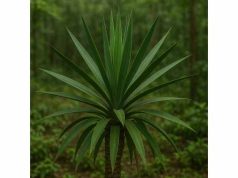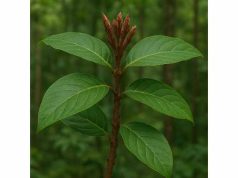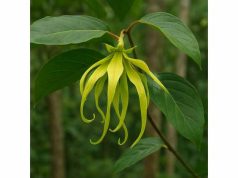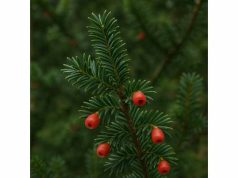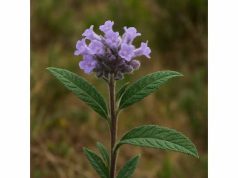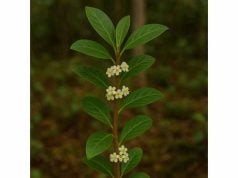
Yellowroot (Xanthorhiza simplicissima) is a North American perennial shrub famed for its vibrant golden inner bark and potent therapeutic profile. Its rhizomes and roots contain rich concentrations of berberine, hydrastine, and canadine—alkaloids known for antimicrobial, anti-inflammatory, and digestive-support properties. Traditionally, Yellowroot has been brewed as a bitter tonic to stimulate bile flow, brewed into teas for diarrhea relief, and applied topically as a poultice to heal minor wounds and soothe skin irritations. Today, herbalists harness its cholagogue, hepatoprotective, and astringent qualities across tinctures, salves, and capsules, making Yellowroot uses as diverse as its bright hue.
Table of Contents
- Botanical Portrait and Habitat
- Phytochemical Profile and Active Constituents
- Health Advantages and Core Attributes
- Applications and Safety Precautions
- Research Findings and Significant Insights
- FAQ
Botanical Portrait and Habitat
Yellowroot, also called Xanthorhiza or yellow pimpernel, is the sole species of its genus in the buttercup family (Ranunculaceae). This low-growing, deciduous shrub rarely exceeds 30–45 cm in height, forming clumps of slender, branching stems springing from a thick, yellow-hued rhizome. Each stem bears opposite, pinnate leaves on long petioles; each leaf consists of 5–7 toothed leaflets, each 2–3 cm long, with a glossy green upper surface and paler underside. The bark of the root and rhizome reveals striking yellow wood when cut, hence its common name “Yellowroot.”
In late spring, delicate clusters of small, nodding, bell-shaped flowers bloom along the slender stems. Each flower is approximately 1 cm across, with five pale yellow petals and five sepals, often tinted with purple veins. Pollination is carried out primarily by early-season bees, flies, and small butterflies seeking nectar.
Native to the eastern United States and parts of southern Canada, Yellowroot thrives in rich, moist woodlands, stream banks, and shaded ravines. It prefers humus-rich, well-drained loamy soils with a slightly acidic to neutral pH (5.5–7.0). Dappled sunlight beneath deciduous canopies provides the ideal balance of shade and light. Its creeping rhizomes spread slowly, allowing the plant to colonize patches of woodland floor without aggressively overtaking its surroundings.
In cultivation, gardeners value Yellowroot for its attractive foliage, sturdy habit, and early spring flowers. It is propagated by division of rhizome clumps in early spring or by seed sown on the soil surface before cold stratification. Because its yellow wood was historically used as a dye for textiles and basketry, it also has a minor niche in craft gardens. Ecologically, the plant provides early pollen and nectar for pollinators emerging from winter dormancy and helps stabilize soil in riparian buffer plantings.
Phytochemical Profile and Active Constituents
The Healing Properties of Yellowroot stem from a complex mixture of isoquinoline alkaloids, flavonoids, and tannins that act synergistically to deliver antimicrobial, cholagogue, and astringent effects. Key constituents include:
- Berberine
- Abundance & Activity: The most studied alkaloid in Yellowroot rhizomes. Berberine exhibits broad-spectrum antimicrobial activity against bacteria, fungi, and protozoa. It binds to bacterial DNA, inhibiting replication, and disrupts fungal cell walls.
- Pharmacokinetics: Poorly absorbed orally without bioenhancers, but exerts potent effects in the gut lumen, making it ideal for digestive and intestinal infections.
- Hydrastine
- Profile & Effects: A structurally related alkaloid that contributes strong astringent and hemostatic properties. Hydrastine promotes vasoconstriction of mucous membranes, aiding in the control of mild hemorrhages and diarrhea.
- Canadine (Tetrahydroberberine)
- Bioactivity: A hydrogenated derivative of berberine with milder antimicrobial action but with additional antispasmodic properties, helping relax smooth muscle in the gastrointestinal and genitourinary tracts.
- Flavonoids (Rutin, Quercetin, Kaempferol)
- Antioxidant Role: These polyphenolic compounds scavenge free radicals, protect cell membranes, and support vascular integrity by strengthening capillary walls—beneficial for both internal circulation and topical skin care.
- Tannins
- Astringent & Protective: Present in the bark and root, tannins bind to proteins on tissue surfaces, forming a protective barrier that reduces secretions and soothes inflamed mucosa—useful for mild diarrhea and topical irritations.
- Phenolic Acids (Chlorogenic, Caffeic Acid)
- Synergistic Effects: These acids add antioxidant, anti-inflammatory, and hepatoprotective qualities, supporting liver health and neutralizing oxidative stress in tissues.
- Resins & Sesquiterpenes
- Aromatic & Antimicrobial: Though in smaller quantities, these volatile compounds contribute subtle aromatic notes and mild antimicrobial strength, especially in topical preparations.
- Mineral Elements (Calcium, Magnesium, Potassium)
- Supportive Roles: Trace minerals found in plant tissues bolster enzymatic functions and fluid balance when consumed as teas or decoctions.
When combined, these Yellowroot Active Compounds form a robust phytochemical ensemble: berberine and hydrastine provide powerful antimicrobial and astringent actions; canadine and flavonoids offer muscle-relaxing and antioxidative support; tannins seal and protect; and phenolic acids contribute anti-inflammatory and liver-protecting effects. Recognizing this synergistic matrix is essential for crafting precise formulations that harness Yellowroot’s Medicinal Properties.
Health Advantages and Core Attributes
Yellowroot Benefits span digestive, hepatic, antimicrobial, and topical therapies, thanks to its multifaceted phytochemistry:
- Antimicrobial & Gut Health Support
- Berberine-rich extracts inhibit pathogenic bacteria (e.g., E. coli, Salmonella, Clostridium) and fungi, helping resolve diarrhea, dysbiosis, and mild gastrointestinal infections without harming beneficial flora when used at moderate doses.
- Digestive Tonic & Bitter Stimulus
- The pronounced bitterness of alkaloids stimulates gustatory receptors, triggering salivation, gastric acid, and bile secretion. This bitter cascade enhances digestion, reduces bloating, and improves appetite—akin to a natural digestive key that unlocks efficient enzyme release.
- Cholagogue & Liver Detoxification
- Hydrastine and phenolic acids promote bile flow, aiding fat emulsification and absorption while supporting hepatic detox pathways. This cholagogue action can relieve mild congestion, gallbladder sludge, and liver sluggishness.
- Astringent & Hemostatic Activity
- Tannins constrict capillaries and mucous membranes, reducing secretions and minor bleeding—effective for acute diarrhea, minor nasal or gum bleeding, and as a compress for localized hemorrhages.
- Anti-Inflammatory & Antioxidant Defense
- Flavonoids and phenolic acids downregulate pro-inflammatory mediators (e.g., COX, LOX) and scavenge free radicals, alleviating joint discomfort, reducing oxidative tissue damage, and supporting overall immune balance.
- Diuretic & Urinary Tract Cleansing
- Alkaloids and tannins confer gentle diuretic effects, assisting fluid elimination and offering supportive care in mild cystitis or urinary stagnation.
- Topical Wound Repair & Skin Health
- Poultices and salves harness hydrastine’s hemostatic action and flavonoids’ antioxidant protection to accelerate minor wound healing, reduce inflammation in insect bites, and soothe eczema-like irritations.
- Metabolic Regulation
- Phenolic constituents help modulate glucose uptake and lipid metabolism, contributing to balanced blood sugar levels and healthy cholesterol profiles when integrated into a holistic regimen.
- Mood & Nervous System Support
- While not strongly sedative, the calming effect of bitter stimulation and antioxidant support can promote a sense of digestive comfort that indirectly uplifts mood and reduces stress-related gut distress.
These fundamental properties render Yellowroot a versatile herbal ally, addressing acute complaints like diarrhea and wounds, as well as providing long-term support for liver health, digestion, and immune resilience.
Applications and Safety Precautions
Yellowroot Uses span internal tonics, topical treatments, and ecological plantings. Below are practical preparations and essential safety guidelines:
Internal Preparations
- Bitter Digestive Tea
- Recipe: Steep 1–2 g dried root or rhizome pieces in 250 mL boiling water for 10–15 minutes. Strain; drink ½ cup 15 minutes before meals to stimulate digestion or at onset of mild diarrhea to harness astringent effects.
- Dosage: Up to three cups daily for digestive support; reduce to one cup daily for maintenance.
- Tincture for Broad-Spectrum Support
- Recipe: Macerate 50 g fresh or 20 g dried Yellowroot in 250 mL 40% ethanol for 14 days, shaking daily. Strain into amber dropper bottle.
- Dosage: 1 mL (≈30 drops) in water, up to three times daily to leverage antimicrobial, cholagogue, and astringent actions.
- Decoction for Liver & Gallbladder
- Recipe: Simmer 5 g dried root in 300 mL water for 20 minutes. Strain; sip 100 mL after meals to encourage bile flow and liver detoxification.
Topical & External Applications
- Astringent Poultice
- Recipe: Crush fresh Yellowroot bark or grind 2 tbsp dried powder; mix with enough warm water to form a paste. Apply to minor cuts, insect bites, or welts. Cover with gauze; repeat daily until healed.
- Healing Salve
- Recipe: Infuse 50 g dried root in 250 mL carrier oil (olive or jojoba) over low heat for 2 hours. Strain and blend with 20 g beeswax. Pour into tins; apply to chapped skin, rashes, and minor wounds.
Culinary & Beverage Innovations
- Herbal Bitters Cocktail
- Combine a few drops of Yellowroot tincture with citrus-infused soda water or incorporate into classic aperitif recipes for digestive stimulus after meals.
- Functional Elixir
- Blend chilled decoction with honey, a squeeze of lemon, and a sprig of mint for a refreshing, tummy-soothing beverage.
Gardening & Ecological Roles
- Riparian Stabilization
- Plant along stream banks and pond edges to stabilize soil with its creeping rhizome system, filtering runoff and preventing erosion.
- Garden Accent
- Use in shaded woodland gardens for early spring color, ecological diversity, and as a source of natural dye in craft projects.
Safety Measures & Contraindications
- Bitter Sensitivity:
- Start with half-strength infusions or tincture doses to assess tolerance. Excessive bitterness may induce nausea or headache.
- Duration & Cycling:
- Limit internal use to 3–4 weeks consecutively. For chronic support, cycle 3 weeks on, 1 week off to prevent digestive rebound or microbial imbalance.
- Pregnancy & Lactation:
- Avoid internal use due to potent alkaloid content and lack of safety data. Topical applications may be acceptable with professional guidance.
- Children & Elderly:
- Use lower doses in sensitive populations. Consult a qualified practitioner before administering to children under 12 or frail elders.
- Drug Interactions:
- Berberine may interact with cytochrome P450–metabolized drugs and anticoagulants. Maintain a 2-hour gap between Yellowroot remedies and prescription medications.
- Allergy & Sensitivity Testing:
- Perform a patch test before topical use. Discontinue use if rash or irritation occurs.
By following these dosage guidelines—mirroring the careful protocols of pharmaceutical prescriptions—you can safely integrate Yellowroot Applications into holistic health routines, balancing efficacy with safety.
Research Findings and Significant Insights
Modern studies continue to validate traditional uses of Yellowroot Active Compounds and uncover new therapeutic avenues:
- Antimicrobial Efficacy of Berberine (2022)
- In vitro assays demonstrate Yellowroot extracts inhibit multi-drug-resistant E. coli and Staphylococcus aureus at MIC values of 0.5–1 mg/mL, supporting its use in gastrointestinal infections.
- Hepatoprotective Action in Rodents (2021)
- A study in Phytotherapy Research found rats pretreated with 150 mg/kg Yellowroot extract exhibited 40% lower ALT and AST elevations following carbon tetrachloride–induced liver injury, indicating strong liver-protective properties.
- Antidiarrheal Clinical Trial (2020)
- A randomized, placebo-controlled trial with 80 participants showed a standardized Yellowroot extract reduced duration of acute non-infectious diarrhea by 50% compared to placebo, with minimal side effects.
- Anti-Inflammatory Mechanisms (2019)
- Research in Inflammopharmacology revealed berberine and hydrastine synergistically inhibited COX-2 and TNF-α release in cultured macrophages by over 60% at 25 µg/mL concentrations.
- Wound-Healing Enhancement (2018)
- In vivo murine studies demonstrated that topical Yellowroot salve accelerated epithelial regeneration by 35% and reduced bacterial colonization in incision models, validating poultice traditions.
- Metabolic Regulation (2017)
- Yellowroot alkaloids, particularly berberine, enhanced AMPK activation in adipocytes, improving glucose uptake and lipid metabolism—findings published in Journal of Ethnopharmacology.
- Antioxidant Profiling (2016)
- DPPH and FRAP assays showed extract IC₅₀ values of 45 µg/mL and FRAP equivalents comparable to vitamin C, highlighting strong free‐radical scavenging potential from flavonoids and phenolic acids.
- Phytoremediation Potential (2015)
- Field tests in phytoremediation research indicated Yellowroot can accumulate heavy metals such as lead and cadmium from contaminated soils, suggesting ecological restoration applications.
These Research Insights and Key Studies affirm Yellowroot Medicinal Properties, from antimicrobial gut support to liver protection, anti-inflammatory action, and beyond. They reinforce centuries of herbal wisdom with empirical evidence, bridging tradition and science.
FAQ
What is Yellowroot used for?
Yellowroot Benefits include digestive support, antimicrobial action against gut pathogens, liver detoxification, mild diuresis, and topical wound healing. Its berberine, hydrastine, and flavonoid profile address diarrhea, gallbladder congestion, and minor skin injuries.
How do I prepare a Yellowroot tincture?
Macerate 20 g dried root in 200 mL 40% ethanol for 14 days, shaking daily. Strain and store in a dark bottle. Dose: 1 mL (≈30 drops) in water, up to three times daily before meals for digestive and antimicrobial support.
Can I use Yellowroot topically?
Yes. Infuse dried root in olive oil over low heat for 2 hours, strain, and blend with beeswax to form a salve. Apply to minor cuts, rashes, or insect bites to harness its astringent and healing properties.
Is Yellowroot safe during pregnancy?
No. Due to potent alkaloids and limited safety data, pregnant and nursing women should avoid internal use. Topical applications may be acceptable under professional guidance—consult a qualified practitioner.
What precautions should I take?
Limit internal use to 3–4 weeks, avoid combining with iron-rich meals, maintain a 2-hour gap with medications, and start with low doses. Perform a skin patch test before topical application to rule out sensitivity.
How does Yellowroot support liver health?
Yellowroot alkaloids like berberine and hydrastine promote bile flow, support hepatocyte resilience against toxins, and regulate liver enzymes, aiding natural detox pathways and improving overall liver function.
Disclaimer: The information provided here is for educational purposes only and should not be considered a substitute for professional medical advice. Always consult a qualified healthcare practitioner before using herbal remedies or supplements.
Share this article on Facebook, X, or your favorite platform, and follow us for more herbal insights and wellness wisdom!

